A good friend of mine recently said this to me:
“Dude, it’s 2023, do you really think you can get traffic and paying customers by targeting low search volume traffic keywords?”
My answer was “yes of course“.
To which he asked:
“How low can you go and still land customers? 200 searches/month? 100 searches/month? Can you go as low as zero searches/month and get customers?”
My answer was: “It’s note really about the volume so much as how relevant the term is to you and your product and how much do you think the volume of this search will grow.”
What I realized as I was talking to my friend is that just like most people he likes to takes the traditional keyword strategy approach when starting an SEO campaign. He aims for mid to high volume keywords, create content, and spend endless months battling it out for the first page.
This approach works, but it’s hard, expensive and ever so often, fails spectacularly.
Instead of doing that I like to take shortcuts. Like Frost, I like to take the road less traveled.
Not long ago I published a case study on TopicRanker titled How to Find Easy to Rank Keywords in 2023 in which I detail how I was able to rank #1 on a brand new domain for a highly relevant keyword in a 2 weeks. I bought this domain on NameCheap which had no blog or website before.
I ended up adopting an approach where I aimed for highly targeted keywords with extremely low search volume and major weakness and problems in the search results. Then I created laser focused content that addressed crucial customer concerns.
I adopted this approach to my other blogs and clients as well. In just 7 months of adopting this approach, I successfully managed to rank several of my pages at the top of the SERPs. These pages brought in over 600 highly targeted visitors, 67 of whom turned into customers with LTV for each customer around $300.
And that’s not a single shot tactic. It adds up over time as you scale it.
I did all this without investing in an expensive and time consuming backlinking campaign.
Here are a few examples of this strategy in action:
TopicRanker.com ranks #1 for “which keyword are best to target” with search volume of 390/mo with this article which brings in 3-5 customers per day: Which keywords are best to target ?
SmallBizTools ranks #2 for “Calendly Alternatives” with this article which brings in great affiliate revenues.
SmallBizTools ranks #2 for “Lifelock vs. Experian” with this article Lifelock vs. Experian : Definitive Comparison.
In this case study below, I’ll show you my exact approach to keyword research, content creation, and conversions. Use this case study to find new untapped keywords and steal customers from your competitors — without even trying!
Ready? Let’s roll!
Going Beyond Popular Keyword Strategies
For many SEOs, the keyword research process goes something like this:
- Find a seed keyword
- Plug seed keyword in a keyword research tool
- Remove all overly competitive and irrelevant keywords
- Make a list of target keywords from the rest.
The selection criteria with this approach is usually an easily quantifiable metric, such as search volume or traffic potential.
In fact, most keyword research tools will even sort all keywords by search volume by default.
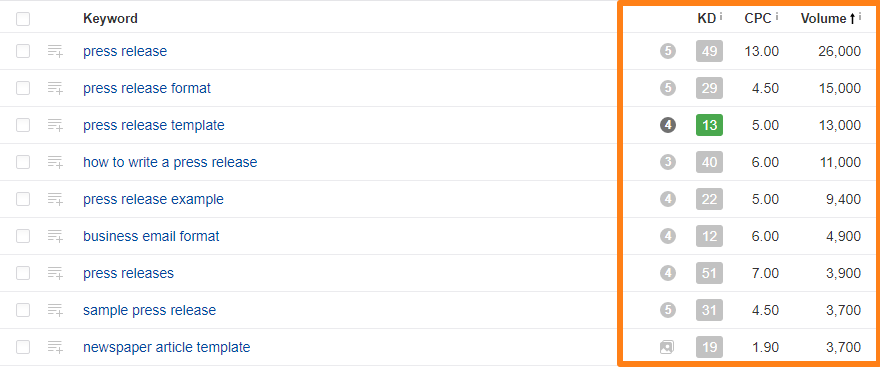
This invariably leads to a situation where you gravitate towards keywords with positive metrics and obvious relevance to your industry. These are often purely informational keywords with little to no buying intent.
For example, if you were to rank my product — JustReachOut, a PR tool — you might pick a keyword like “press release template”.

It has all the right metrics — 13k searches, $5 CPC — and industry relevance.
The problem?
All your competitors have the same idea as well. Just like you, they’re also looking for strong metrics and relevance.
This results in an intense competition where the only way to rank is to out‐create and out‐link everyone else.
In my “press release template” keyword, for example, I would have to beat HubSpot, Office.com, and CBSNews for a top spot.

That’s some tough competition.
But as I’ll show you below, it doesn’t have to be this way.
With a tangential approach, you can avoid this competition altogether, and still land customers.
A Smarter Approach to Keywords
With this approach, you ignore the metrics everyone else is using to select their keywords — search volume, CPC, competitiveness, etc.
Instead, you focus on keywords where you can:
- Intercept the customer in the middle of the purchase decision
- Piggyback on the authority of an established player in a related field
- Offer a better solution to a problem posed by an established player in your field
You’ll still use metrics, of course, but you’ll use them as qualifying criteria, not selection criteria.
This approach works because of:
- Low competition: Since you’re targeting unconventional, low‐traffic keywords, you won’t have much competition in the SERPs. This means that you can often rank without even building any backlinks.
- Targeted traffic: The keywords you’ll use with this approach will be very specific and bring in extremely targeted traffic. Your conversions will accordingly be high, as I’ll show you below.
- Business‐focus: Instead of simply looking at metrics, these keywords address core issues and concerns customers have about your or your competitor’s product. This “business‐focused” approach can often yield more targeted traffic.
In the next section, I’ll show you how the first type — ‘Intercept’ keywords — work.
I. Intercept Keywords: ‘Steal’ Customers from Your Competitors
Imagine that you’re in the market for a new pair of running shoes.
You drive over to Target and try out a dozen different pairs. The salesperson explains how to choose a running shoe, what kind of fit to look for and which brands to buy.
After an hour of trial and error, you finally settle on a pair. Pleased with your decision, you head over to the checkout counter.
Before paying, however, you remember that you’d downloaded Amazon’s Price Check app to check prices online before buying.
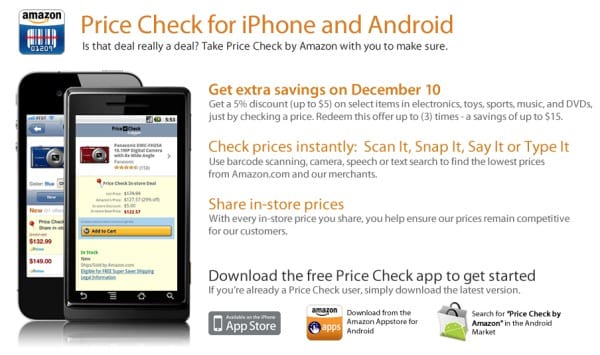
So you whip out your smartphone, open the Amazon app, and do a quick search.
Sure enough, the shoes are $20 cheaper on Amazon, and you decide to order them online.
In other words, Amazon intercepted your purchase decision.
The store did all the selling. Amazon only appeared when you had to make the all‐important purchase decision.
It didn’t have to convince you to buy the product; the store’s staff had done that already. It only offered you a lower price and made the actual sale.
What I just described happens every day. 65% of US consumers conduct online product research before heading to a store. 25% of customers use their mobiles to make a purchase while they’re in the store.
No wonder that Amazon even has a patent to stop people from price shopping inside its own store.
But how does all this have relevance to us online?
Easy: just like Amazon, you can also intercept shoppers’ purchase decision by targeting the right set of keywords.
I call these Intercept Keywords.
What Are Intercept Keywords?
Recall that a customer’s shopping process can be described as a “buyer’s journey” where he moves from ignorance to knowledge to a final decision.
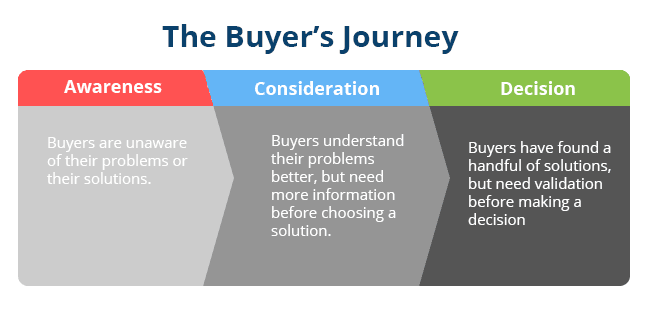
By the time this customer reaches the ‘Decision’ stage, he’s already done a ton of research about the product. He’s read multiple blog posts, analyzed his requirements and compared features.
But right before he hands over his credit card, he hesitates. He isn’t sure if the product is perfect for him. Or maybe he’s unsure of its price.
This is particularly true for B2B products where customers know they’ll likely be locked into the product for months, if not years.
So what does this hesitant customer do?
He searches for alternatives and compares their features and prices. He tries to find something better, or maybe something open source.
This is exactly where you come in and intercept the customer’s shopping process.
Keywords that describe such interceptions are intercept keywords.
Example
For example, I made this page for JustReachOut targeting the keyword “Cision alternative”:
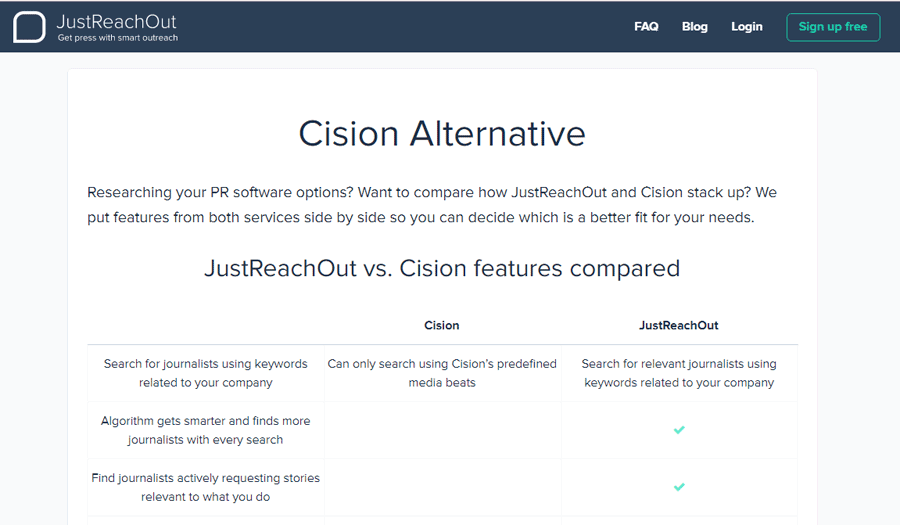
Cision is a major player in the PR software field. It dominates online, ranking for thousands of keywords and getting no fewer than 100k organic visitors each month.

Far more people search for Cision than they do for JustReachOut.

However, it is an expensive piece of software. It is also complex and too powerful for most casual users. Unless you’re running a full‐fledged marketing/PR agency, you won’t really make the most of the software.
This is where JustReachOut comes in.
By creating a page titled ‘Cision Alternative’, I’m explicitly targeting customers who:
- Want PR software (considering that they’re searching for ‘Cision alternative’)
- Know about Cision (since they’re searching for it)
- Want an alternative that fulfills their requirements
I don’t have to do the hard work of educating my customers about PR software; Cision (and others) have done that for me.
In fact, Cision Canada even ranks for “what is PR software”:
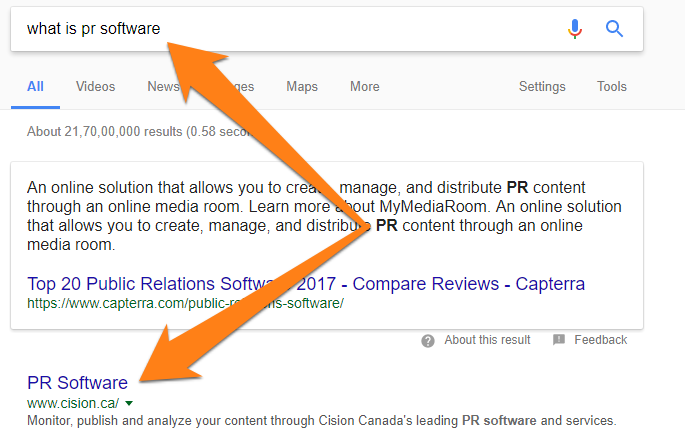
Instead of targeting such low‐information customers, I only intercept customers who already know about PR software and Cision and want an alternative.
“Cision alternative(s)” and “alternative(s) to Cision” aren’t major keywords in terms of search volume. If going by metrics was your only criteria, you’d reject them outright.
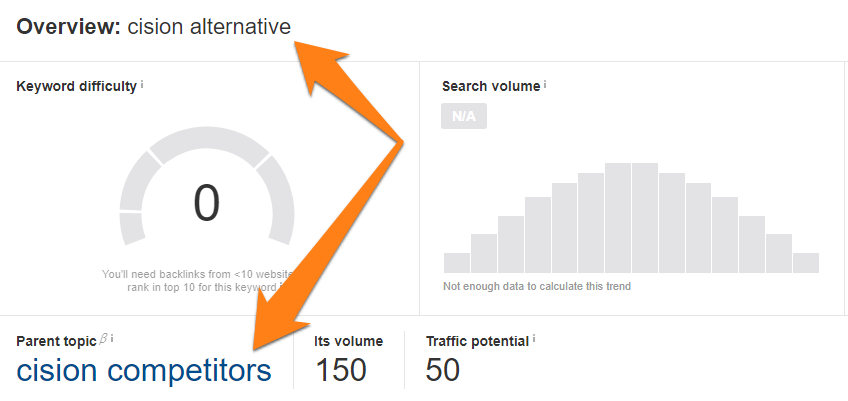
There is a higher‐volume parent topic — “Cision competitors” — but I even rejected that because it’s competition was too high.
Instead, I targeted an “unsexy” keyword with non‐existent metrics.
Yet, this ‘low‐volume’ keyword has earned me 10 paying customers in just one month with a conversion rate of 3.5%.

All this with just one backlink (and that too from my own site):

Why did this work?
Because I intercepted the customer while he was in a decision‐making process, highlighted the pros of my product, and offered him something that solved his major pain points.
And because my strategy was to target a keyword so low on the totem pole that most people would ignore it completely, I had no difficulty in ranking for it.
This is the power of intercept keywords.
How to Find Intercept Keywords
To find intercept keywords, think of how a typical customer would approach a purchase decision for a product.
What questions would this customer ask himself before deciding what to buy? Would he look for alternatives? Would he look for better prices? Would he compare the product he’s chosen to another?
Essentially, you’re looking for keywords which indicate:
- That a customer has sufficient knowledge about the product. This usually means that the keyword includes the name of the product.
- That a customer is hesitating before making a purchase decision. Searching for “better”, “cheaper”, “faster” alternatives, or comparing two products is a good sign.
To find intercept keywords, pick a major competitor. Plug its name into the Ahrefs’s Keywords Explorer, then select “All” under ‘Keyword Suggestions’ in the left pane.
On the next screen, add words that imply a hesitation in the customer’s decision in the ‘Include’ field.
Some of these words are: alternative, flaw, better, cheaper, issues, vs, faster, comparison/compare, etc. For software products, you can also use ‘free’, ‘open source’.
Add these, one by one, to the ‘Include’ keywords list.
For example, here’s what you’ll see if you set a filter for keywords that contain “alternative” for HubSpot:
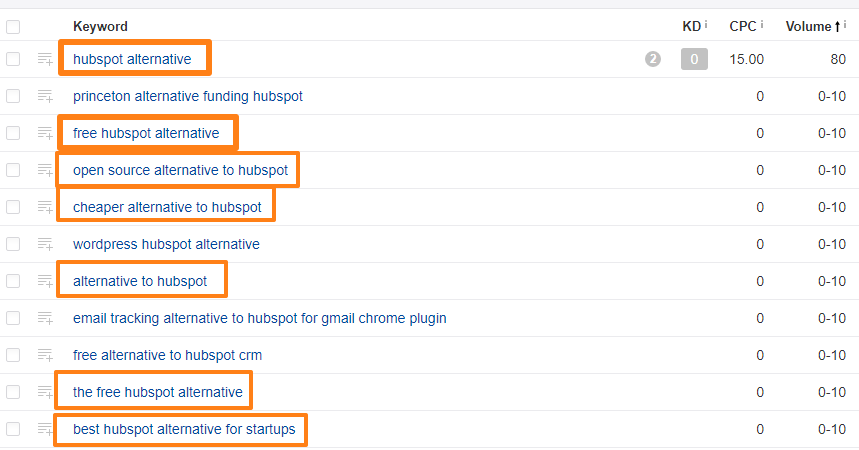
And this is what you see if you filter for keywords with the word “better” in them:
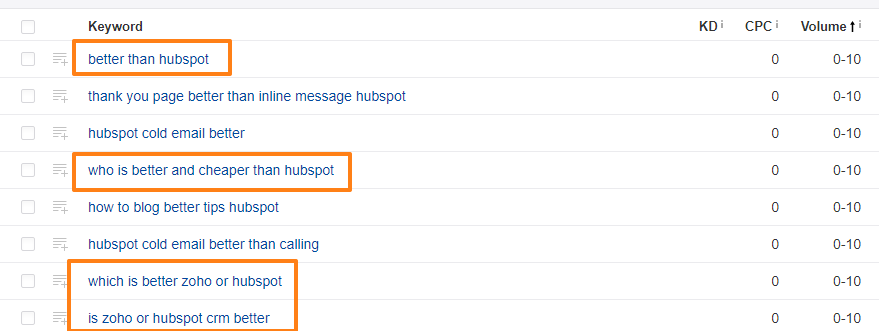
Anyone searching for the highlighted keywords shows that they have sufficient knowledge about the market. They’re also hesitant to make a decision; else they wouldn’t look for “better” or “cheaper” alternatives.
If you create a page that targets these concerns, you have a good chance of landing some of these customers.
Don’t be turned off if your target keyword has 0–10 searches/month. This doesn’t necessarily mean that no one is searching for these terms. Rather, it means that people might be using alternative terms and phrases with these queries.
If you do create content for these keywords, Google will send all these people to you since you’re the only one targeting them.
A NOTE ABOUT INTERCEPT KEYWORDS
When you use intercept keywords, you are essentially comparing yourself to competitors.
It’s important to be truthful here. Any information you show on your page must be honest and accurate. Else your competitors will complain and your customers will lose trust.
A good approach is to focus on your product’s pros instead of the competitor’s cons. Play up what makes your product great instead of simply bashing the competitor.
It’s also a good idea to avoid a competitor’s native terms they’re bidding for, such as “[competitor] features”, “[competitor] pricing”, etc.
For example, I had one competitor — Muckrack — complain about my “Muckrack Alternative” page since I was ranking for their native term, “muckrack pricing”. So I redirected it to my page on how to use HARO.
This page now ranks on the first page for “muckrack alternative”!
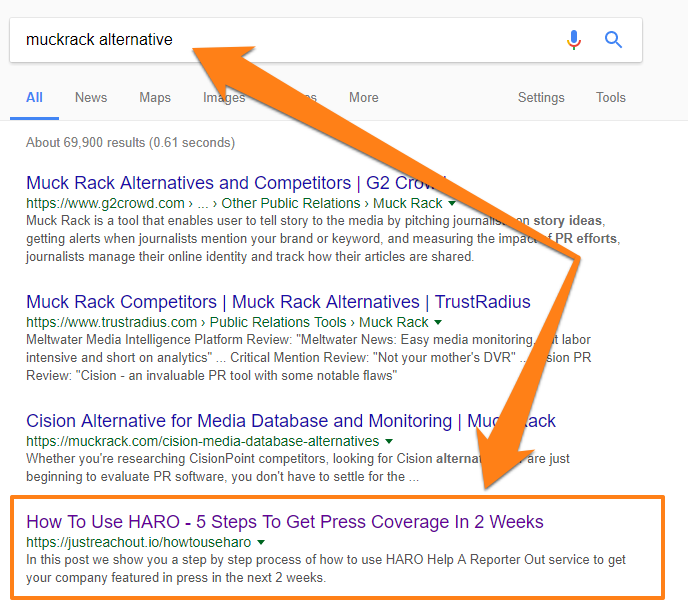
In the next section, I’ll share another highly lucrative, but equally ignored keyword type — the “piggyback” keyword.
II. Piggyback Keywords: Build Your Base on Another’s Authority
In every industry, there are a few established players that dominate the market.
Because of their dominance, a number of companies “piggyback” on their success by making products that appeal to their customers.
The mobile accessories market is a perfect example. This market has ballooned to tens of billions of dollars based on the popularity of smartphones.
In other words, mobile accessories manufacturers have “piggybacked” on the success of smartphone companies.
You’ll find this to be true for any popular product. Its customers will invariably want to know if they can use it with another product.

For us, this represents a massive opportunity, but the one that isn’t always clear.
For one, you’ll rarely find these piggyback keywords in search results — their search volume is too tiny to register.
Instead, you’ll have to “make” these keywords yourself by guessing customer demand.
But first — what exactly are piggyback keywords and how do they work?
What Are Piggyback Keywords?
Piggyback keywords represent the intersection of two products’ users — an established one, and yours.
The established product is usually not a competitor. Instead, it’s a product in a closely related field.
People who use this product often look for solutions that work well with it. For instance, you often hear of how a new productivity software is no good because “it doesn’t work with Gmail or Outlook”.
I’ll show you an example that makes this much more clear.
Example
HubSpot is the Goliath of the content/inbound marketing field. It dominates the marketing mindspace and occupies thousands of keywords.

As inbound marketers, HubSpot’s customers are interested in getting backlinks and mentions on authority sites.
However, because they’re usually inbound agencies and not PR agencies, buying a suite of expensive PR tools makes no sense for them.
A solution that is leaner and targets their specific needs works better for them.
Hence, I created this page:
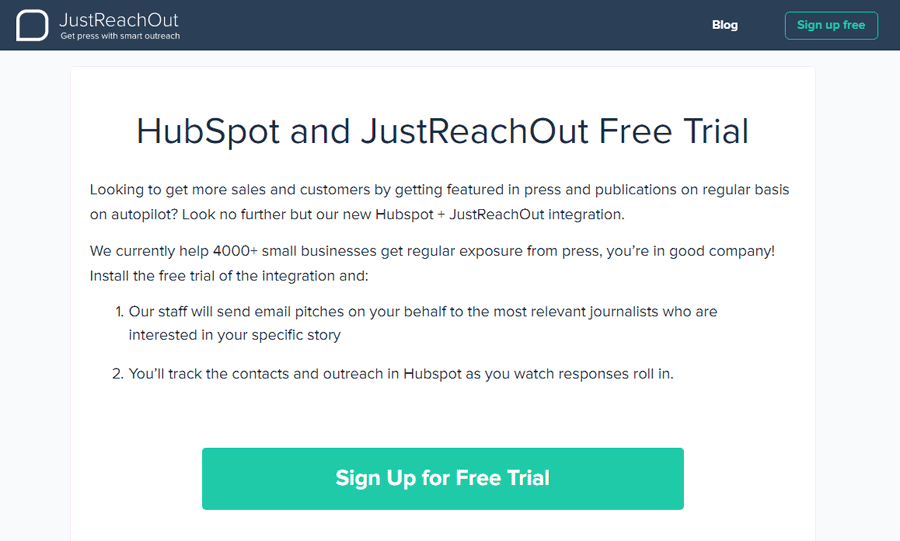
This page advertises a free JustReachOut trial for HubSpot’s users. The keyword is branded, implying awareness on the searcher’s part of HubSpot, JustReachOut or both.
This branded keyword “Hubspot JustReachOut” has no search volume.
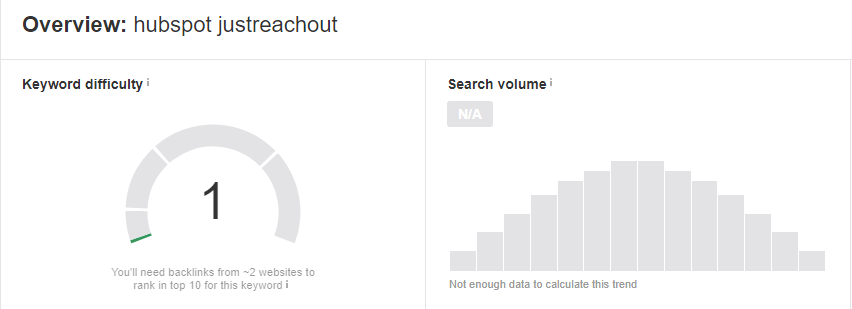
Yet, it ranks for a number of branded keywords, particularly those related to HubSpot — HubSpot trial, HubSpot PR, HubSpot sales vs outreach, etc.

All of these present opportunities to sell to people who are already aware of HubSpot, and thus, piggyback on its authority.
This is how this low‐traffic page got me 3 paying customers from 297 visitors in the last month:

If I had taken the traditional approach to keywords, I wouldn’t have even thought of this page.
How to Find Piggyback Keywords
With these keywords, you have to first find a popular product in a closely related field to piggyback on.
This product usually:
- Has a large number of users
- Dominates a closely related but larger field (PR > Marketing; Email Tracking> Sales CRM, etc.)
- Offers some way to pair up with it (such as an API to integrate with)
Your goal is to ask: What do people who use this software want to do, and how can I fill that gap?
For example, a salesperson using Outlook would want to track how his emails are performing. He might search for “track sales emails with Outlook”.
These are the top results for this search:
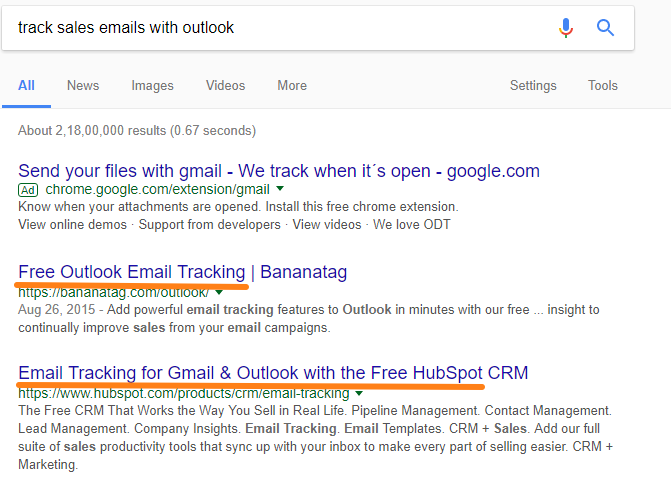
In this case, both Bananatag and HubSpot have piggybacked on a popular software — Outlook — and used it to push their own services. The targeted content is specifically tailored for Outlook users who want to do a specific thing — “track sales emails”.
This is precisely what you have to do: find out how a popular product’s user requirements intersect with yours.
And again Ahrefs comes in pretty handy here.
Start by searching for the popular product’s website in Ahrefs Site Explorer. Then select ‘Organic Keywords’ in the left pane.
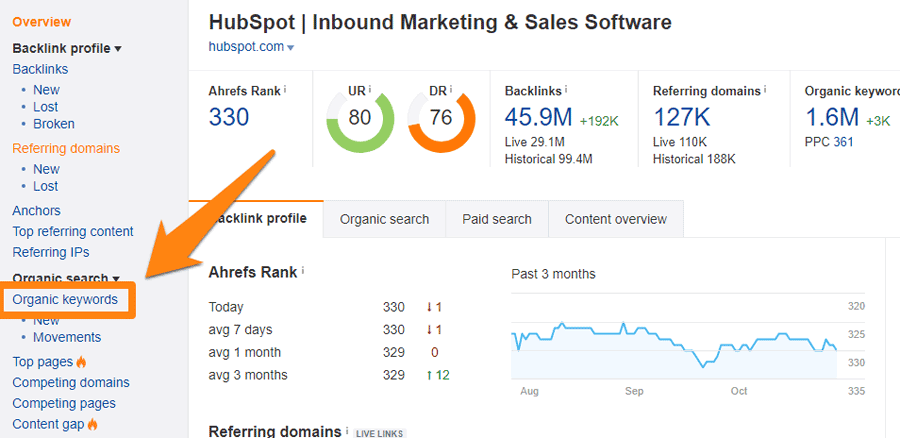
On the next screen, search for a broad keyword related to your product. In my case, it would be “press” or “journalist”.

This will show you all the pages on the product’s site that rank for keywords with your target word in it.
Don’t worry about the search volume. Rather, consider how closely related the search is to your product.
In my case, it tells me that people who use HubSpot want to know “how to email a press release to a journalist” and where to find “journalist database”.
Both of these are services JRO provides.
Thus, creating a HubSpot + JRO integration page makes it possible for me to piggyback on these HubSpot users who are aware of HubSpot (because they are making branded searches).
Simple, but highly effective.
III. “Faster Solution” Approach: Help People Use a Popular Tactic
This is like the piggyback approach, but with a twist.
Instead of finding a popular product in a related field, you find a popular tool related to a dominant in your field. Then you help people use that tool better.
The theory goes: if you create a definitive resource for a tool you’ll show up when people search for that tool.
And this gives you an opportunity to pitch your product instead of the free tool.
Let’s see how these keywords work below.
What are “Faster Solution” Keywords?
In every industry, there are some dominant and well‐known tactics. For each of these tactics, there are also a few popular tools to do them faster.
In the SEO industry, for instance, “broken link building” is a popular tactic for building links.
To be good at this tactic, you’ll likely use several tools — Google, Ahrefs, Xenu, ScreamingFrog, etc.
Now anyone who wants to be good at broken link building will also want to be good at one (or all) of these tools.
If you can create a definitive resource to using these tools, you have a good chance of showing up when someone searches for “how to use [x]” (as Moz does here):
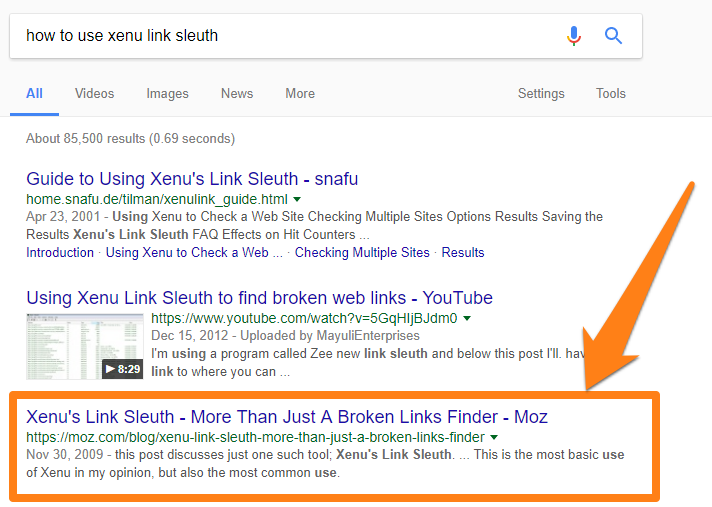
And when they land on your site, you can pitch them your product as a “faster solution” to the tool in question.
This is similar to the above‐mentioned tactic in that you’re also piggybacking on a popular tool.
I’ll show you how this approach works with an example.
Example
One of the most popular tools in the PR field is called HARO — Help a Reporter Out.
HARO connects journalists with sources. Journalists email HARO with their requirements — say, a quote for a story, a suitable candidate for an interview, etc.
HARO sends out an email to all its subscribers with the request. Anyone interested in the request — marketers, entrepreneurs, bloggers, etc. — can reply to the journalist and get a press mention. All for free.
You can gauge the popularity of HARO by its search volume:

HARO is self‐explanatory enough, but people still need some guidance on how to use it.
This is a tiny minority as represented by the search volume for “how to use HARO”:
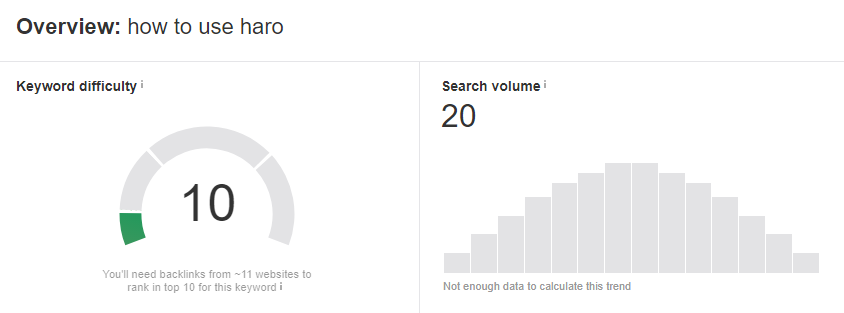
But as we’ve learned so far, low search volume can lead to customers if you pitch your product right.
Plus, low search volume often leads to more traffic than the search volume indicates. As Ahrefs’ research shows, the average #1 ranking page will also rank for 1,000 other relevant keywords.
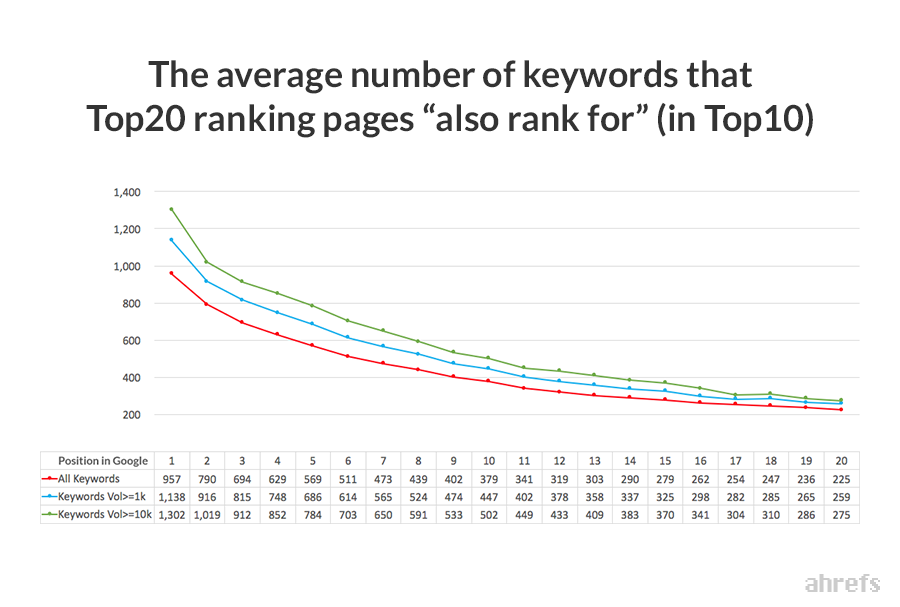
In other words, you can expect to get much more than just 10 visitors/month if you rank for a keyword with 20 searches/month.
Keeping this in mind, I created this page:
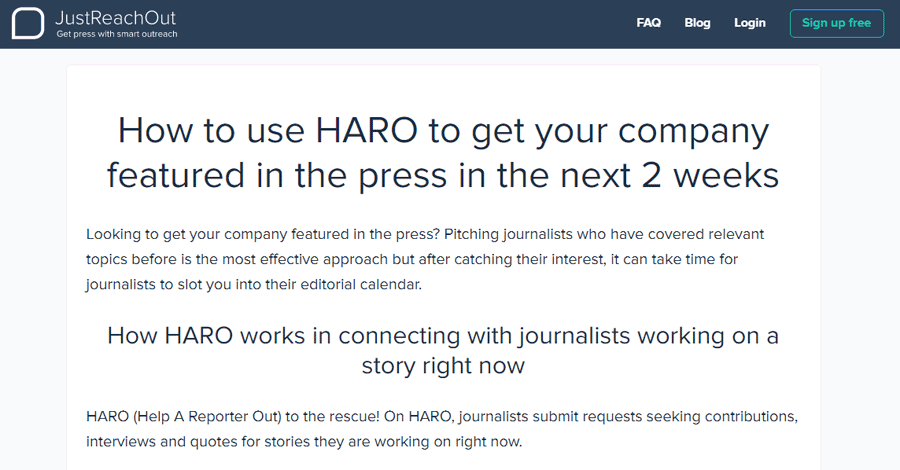
This is essentially a step‐by‐step guide to using HARO.
Keeping in line with Ahrefs research, I quickly started ranking for a number of keywords related to using HARO:
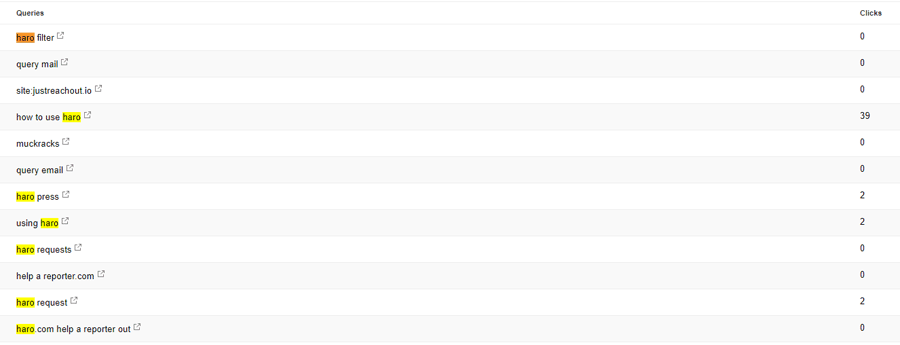
The traffic isn’t much, but it still ended up getting me 7 paying customers.

All of this without even building any backlinks to the page!
In the next section, I’ll show you how to find such keywords.
How to Find ‘Faster Solution’ Keywords
To find these keywords, you have to first:
- Find a popular tool related to what you do
- Find keywords people use in relation to said tool
For #1, Google is your best friend. Pick a tactic or activity (“pitch journalists”, “build backlinks”), then use searches like “best tools to [x]” to find tools for it.
Make a list of all tools you find, then plug them into Ahrefs’ Keywords Explorer. Your goal is to target the most popular tools among them (by search volume).
In this case, it’s HARO:
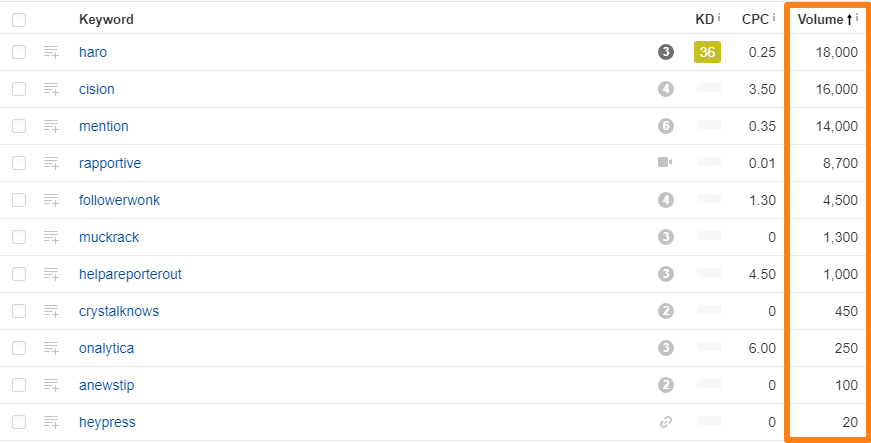
Next, search for this tool in the Keywords Explorer. In the left pane, select ‘All’.
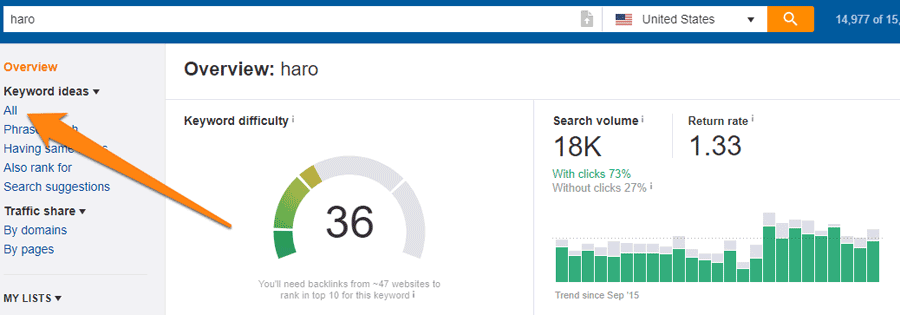
On the next screen, our goal is to find how people use this tool, then create a definitive guide around it.
Since we’re looking for doing, i.e. activity words, use the keyword length filter to only look for keywords with 3–8 words in them. Keywords shorter than that rarely relate to specific activities.
Also, add the keyword “how” to the list of words to include. Again, “how” keywords are usually activity related.

Now go through the list of keywords. See anything that is a) related to HARO, and b) related to how people use HARO (to find journalists, to find sources, etc.).
For example, all these keywords are somehow related to HARO:
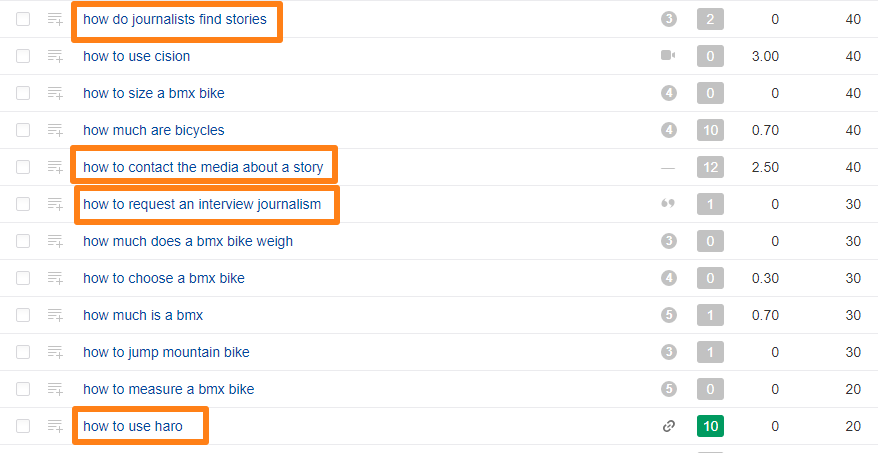
I could target any of them and still land customers thanks to their specificity.
Once you find such keywords, create content around them. Your goal is to position yourself as a definitive resource on that topic.
Once you start ranking, pitch your product as a ‘faster’ alternative and watch the customers roll in.
In the next and final section, I’ll share some tactics to get the most out of this unusual approach to keywords.
How to Make the Most of This Approach
Finding highly targeted low‐volume keywords and creating content for them is half the battle won.
But to get the most out of this approach, you can do a few more things:
1. Use Contextually Relevant CTAs
When you’re working with low‐volume keywords, maximizing conversion rates should be a top priority.
One way to do that, of course, is to use the right kind of CTAs.
Think from the perspective of a visitor landing on a page. What are this visitor’s top concerns and questions? How can you address them?
For example, on this page about using HARO (the ‘faster solution’ approach), I used a CTA that emphasizes ‘automating’ PR outreach:
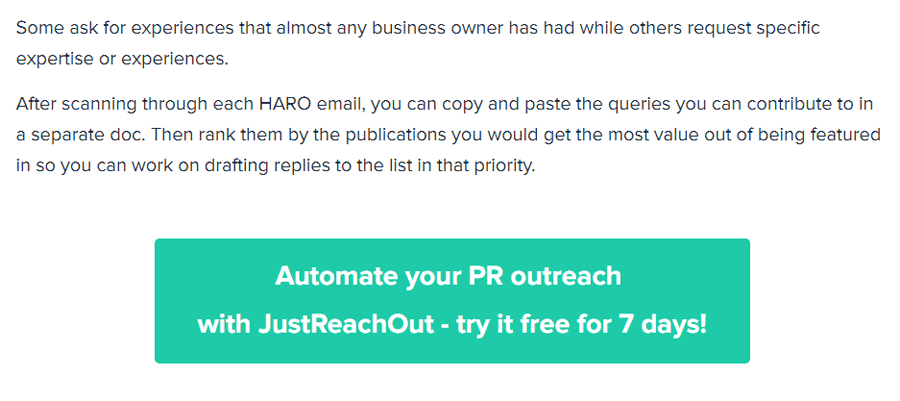
The page itself talks about making better use of HARO. It stands to reason that someone who wants to use HARO would also be interested in automating the process.
On this page targeting an intercept keyword — “Cision alternative” — I used a CTA that emphasized the risk‐free nature of my product:
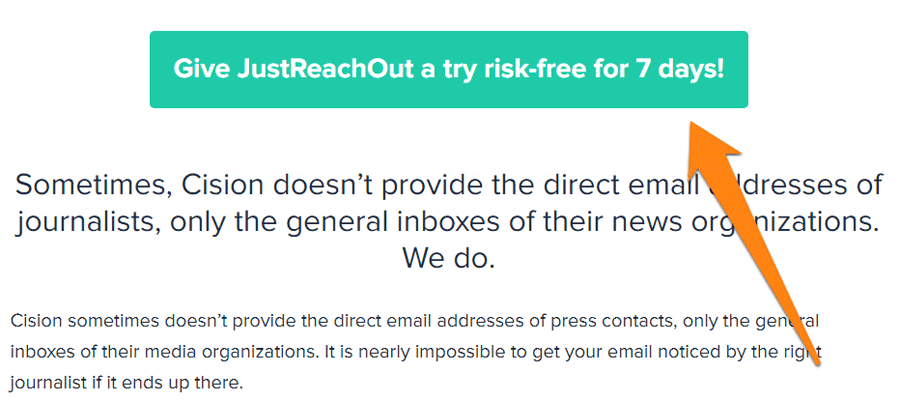
The “risk‐free” part appeals to a customer who is highly interested in a product category but is circumspect about making an investment. This helps improve conversions.
So instead of using the same CTA on every page, use something that is contextually relevant to the visitor’s concerns and requirements.
2. Catalog Competitors and Relevant Tools & Tactics
The traditional keyword strategy sees competitors as a challenge.
Our approach treats them as opportunities.
The more competitors you have, the more opportunities you’ll get to position yourself as a better, cheaper and faster solution.
So start by cataloging:
- Competitors and what issues/concerns people have about them. Figure out how your product can help address these concerns, then position yourself as an alternative.
- Dominant tools and tactics that people in your industry know and search for. Create guides that help them make better use of these tools. Position yourself as a faster way to get the same results.
- Related products that dominate a closely related industry. Figure out how people can use your product in relation to them.
3. Align Activity and Need
If you were selling running shoes, where would you rather sell them?
- Outside a running track filled with amateur athletes
- Outside a candy store
The former, of course.
The reason for this choice is simple: a person running on a track is primed to want tools that enhance his activity. There is contextual alignment between activity and need.
The same applies to products online as well.
A person buying an SEO product isn’t only searching about SEO; he is also searching for answers in a number of closely related fields — PR, inbound marketing, email tracking, data mining, web scraping, etc.
The need is to grow traffic/rankings. The activity to get there might be SEO with a mix of PR, data mining, etc.
Focus on these when you create content or search for keywords. Think of the primary needs of your customers. Then think of all the activities and tools they might use to fulfill their needs.
Create content around these activities — even if they’re unrelated to your field — to lure in these customers.
4. Scale
A low‐traffic keyword by itself won’t send you enough traffic to make a significant impact on your business.
But because creating such pages is easy (and often requires no backlinks to rank), you can easily scale to cover hundreds of keywords.
At that volume, the sheer number of pages would bring in lots of traffic.
Keep in mind that a #1 ranking page will be getting you traffic from hundreds of related keywords as well.
So with a hundred of #1 ranking pages, you’re looking at traffic from potentially thousands of keywords.
This is the key to succeeding with this strategy. Instead of focusing on a single keyword, scale. Target as many “unpopular” keywords as you can, preferably those with some ‘buying’ intent.
This has the added benefit of risk reduction. Even if you fail to rank for a few keywords, you wouldn’t have invested tens of hours into creating content and building backlinks.
Over to You
Going after popular keywords works, provided you have the time and budget for it.
If you’re short of either, a tangential approach can work better.
This approach eschews conventional long‐tail keywords and targets extremely low‐traffic but highly targeted keywords.
These are keywords where you can intercept the customer in the middle of the purchase process, piggyback on the success of a popular product, or offer a faster solution to a common problem.
The low search volume and limited competition of such keywords mean that you can rank without investing in backlinks. And when paired up with the right kind of copy and offers, you can land hundreds of paying customers from them over time.
- Going Beyond Popular Keyword Strategies
- A Smarter Approach to Keywords
- I. Intercept Keywords: ‘Steal’ Customers from Your Competitors
- II. Piggyback Keywords: Build Your Base on Another’s Authority
- III. “Faster Solution” Approach: Help People Use a Popular Tactic
- How to Make the Most of This Approach
- Over to You
Curious – is it worth focusing on alternative to keywords if you already see others ranking for this term?
I think it is still worth doing so if you do not see specific blogs with a topic depth around that keyword already ranking for it. In other words if it’s just a bunch of directory websites ranking for it – then you can go for it since your site has more topic depth and expertise on that topic. For example for “alternative to cision” I just saw Capterra there – I knew JustReachOut was a better fit because the topic depth is all about PR tools. Does this make sense?
Great post, it’s a behemoth. I had to download it into a PDF and save it on my desktop. So much info here. Your tip on intercept keywords – where you steal customers from competitors is awesome. Going to try that out. thx.Jenna
100% Jenna. Any questions just hit the contact link.
Love the post. My domain authority is 0… lol, no idea where to even start. Seems like everyone already has some DR.
Everyone starts somewhere! I would focus on super long tail keywords and on 10X the quality of content compared what is ranking on Google now for that keyword. Great content attracts links and grows your DR. It does take time. It doest not happen fast. Nothing great was built in a day. Make sense?
You don’t talk about link building much here… do you ever think about that while doing keyword research?
Brady- absolutely! Here is a case study of how I did this for Pipedrive back in the day: https://moz.com/blog/case-study-ranking-high-volume-keyword
Step by step there, just go to Link building section where I talk about guest pots and other tactics. Let me know if you have other questions.
Nice post, very thorough. One question I had was about creating content about a specific keyword. How do you come up with an outline?
thanks Angela. Sure, I break down the whole process of writing the content here: https://www.criminallyprolific.com/press/#dmitry's-rhodium-2019-preso-w/slides:-how-to-use-seo-and-pr-to-acquire-customers